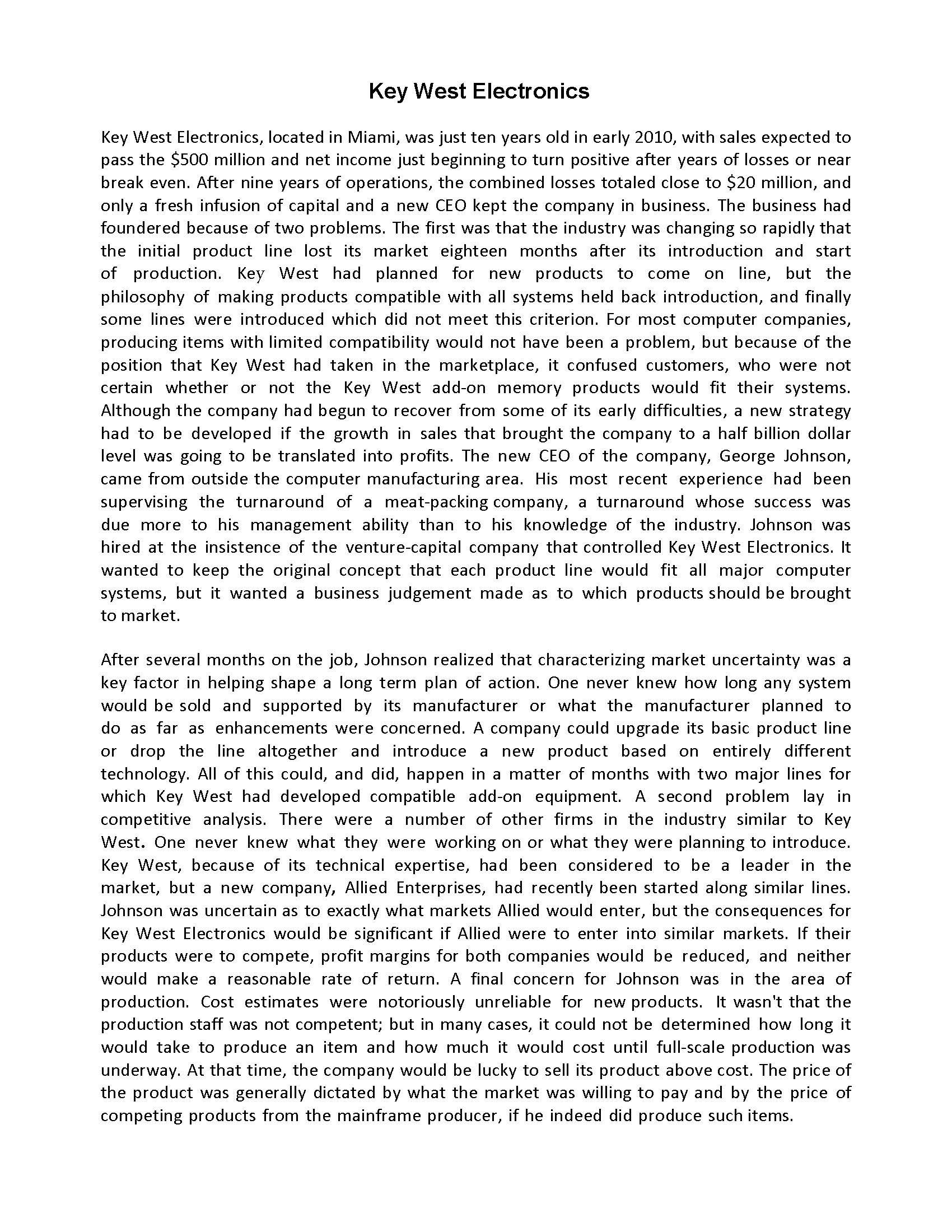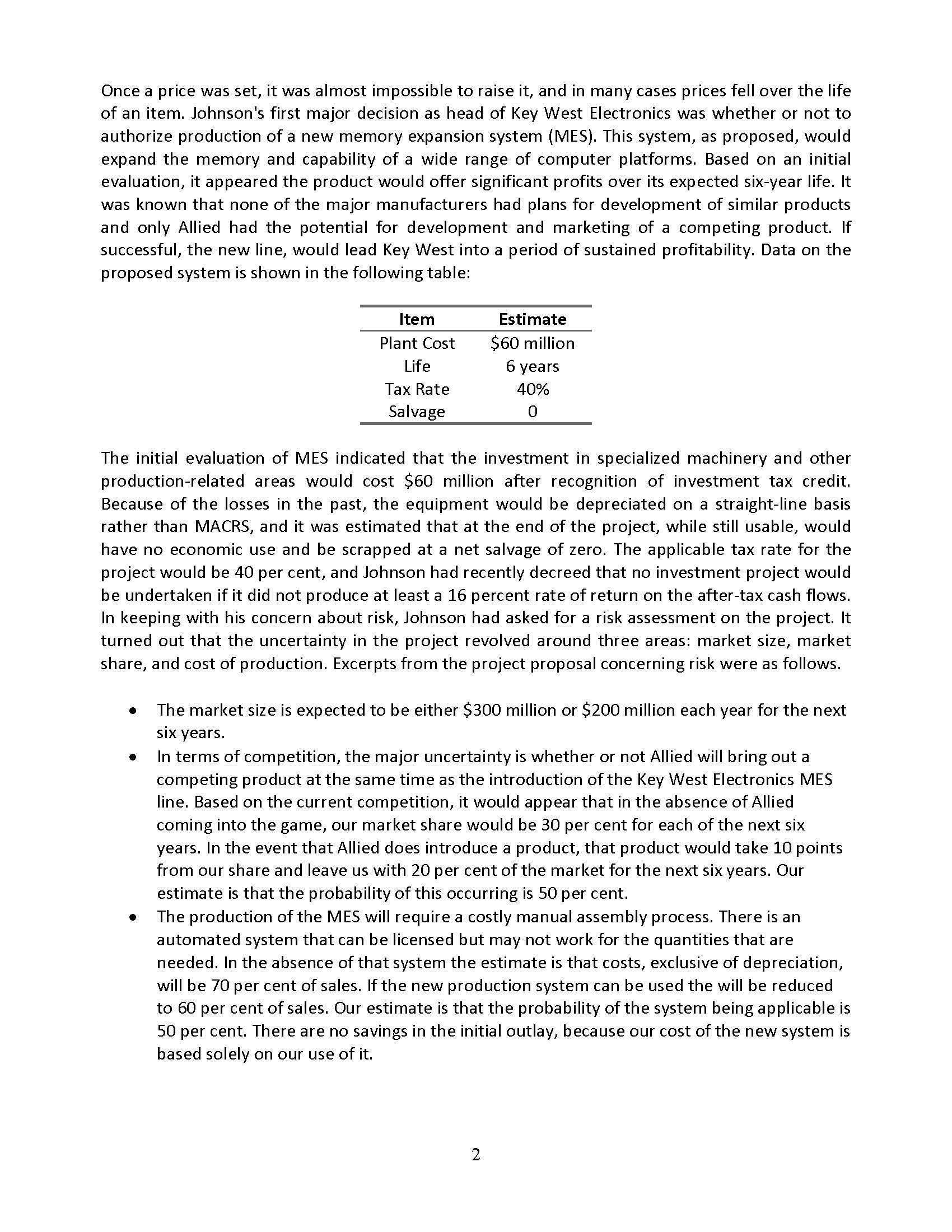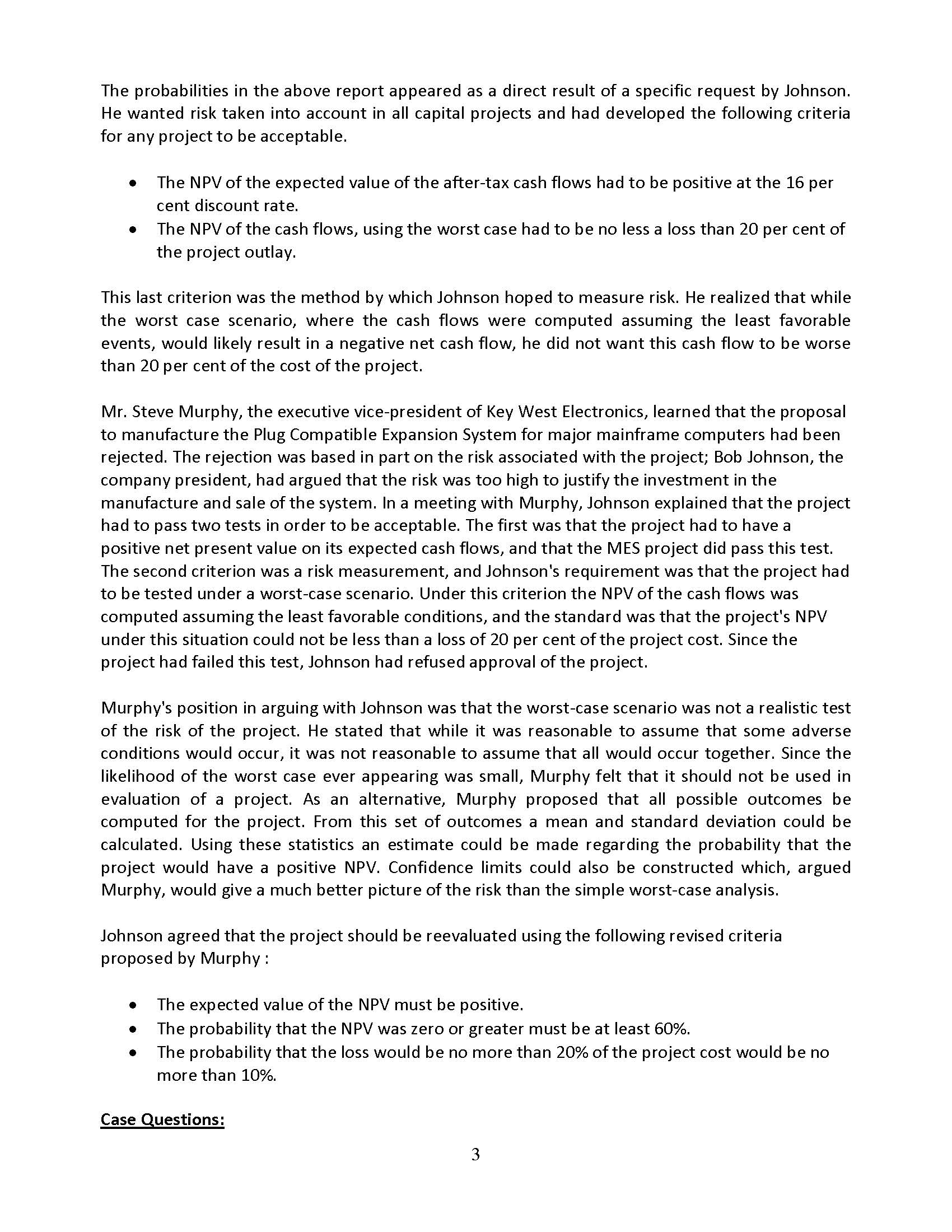Please see attached files for details.
Key West Electronics Key West Electronics, located in Miami, was just ten years old in early 2010, with sales expected to pass the $500 million and net income just beginning to turn positive after years of losses or near break even. After nine years of operations, the combined losses totaled close to $20 million, and only a fresh infusion of capital and a new CEO kept the company in business. The business had foundered because of two problems. The first was that the industry was changing so rapidly that the initial product line lost its market eighteen months after its introduction and start of production. Key West had planned for new products to come on line, but the philosophy of making products compatible with all systems held back introduction, and finally some lines were introduced which did not meet this criterion. For most computer companies, producing items with limited compatibility would not have been a problem, but because of the position that Key West had taken in the marketplace, it confused customers, who were not certain whether or not the Key West add-on memory products would fit their systems. Although the company had begun to recover from some of its early difficulties, a new strategy had to be developed if the growth in sales that brought the company to a half billion dollar level was going to be translated into profits. The new CEO of the company, George Johnson, came from outside the computer manufacturing area. His most recent experience had been supervising the turnaround of a meat-packing company, a turnaround whose success was due more to his management ability than to his knowledge of the industry. Johnson was hired at the insistence of the venture-capital company that controlled Key West Electronics. |t wanted to keep the original concept that each product line would fit all major computer systems, but it wanted a business judgement made as to which products should be brought to market. After several months on the job, Johnson realized that characterizing market uncertainty was a key factor in helping shape a long term plan of action. One never knew how long any system would be sold and supported by its manufacturer or what the manufacturer planned to do as far as enhancements were concerned. A company could upgrade its basic product line or drop the line altogether and introduce a new product based on entirely different technology. All of this could, and did, happen in a matter of months with two major lines for which Key West had developed compatible addon equipment. A second problem lay in competitive analysis. There were a number of other firms in the industry similar to Key West. One never knew what they were working on or what they were planning to introduce. Key West, because of its technical expertise, had been considered to be a leader in the market, but a new company, Allied Enterprises, had recently been started along similar lines. Johnson was uncertain as to exactly what markets Allied would enter, but the consequences for Key West Electronics would be significant if Allied were to enter into similar markets. If their products were to compete, profit margins for both companies would be reduced, and neither would make a reasonable rate of return. A final concern for Johnson was in the area of production. Cost estimates were notoriously unreliable for new products. It wasn't that the production staff was not competent; but in many cases, it could not be determined how long it would take to produce an item and how much it would cost until full-scale production was underway. At that time, the company would be lucky to sell its product above cost. The price of the product was generally dictated by what the market was willing to pay and by the price of competing products from the mainframe producer, if he indeed did produce such items. Once a price was set, it was almost impossible to raise it, and in many cases prices fell over the life of an item. Johnson's first major decision as head of Key West Electronics was whether or not to authorize production ofa new memory expansion system (MES). This system, as proposed, would expand the memory and capability of a wide range of computer platforms. Based on an initial evaluation, it appeared the product would offer significant profits over its expected six-year life. It was known that none of the major manufacturers had plans for development of similar products and only Allied had the potential for development and marketing of a competing product. If successful, the new line, would lead Key West into a period of sustained profitability. Data on the proposed system is shown in the following table: Item Estimate Plant Cost $60 million Life 6 years Tax Rate 40% Salvage 0 The initial evaluation of MES indicated that the investment in specialized machinery and other productionrelated areas would cost $60 million after recognition of investment tax credit. Because of the losses in the past, the equipment would be depreciated on a straightline basis rather than MACRS, and it was estimated that at the end of the project, while still usable, would have no economic use and be scrapped at a net salvage of zero. The applicable tax rate for the project would be 40 per cent, and Johnson had recently decreed that no investment project would be undertaken if it did not produce at least a 16 percent rate of return on the after-tax cash flows. In keeping with his concern about risk, Johnson had asked for a risk assessment on the project. It turned out that the uncertainty in the project revolved around three areas: market size, market share, and cost of production. Excerpts from the project proposal concerning risk were as follows. 0 The market size is expected to be either $300 million or $200 million each year for the next six years. 0 In terms of competition, the major uncertainty is whether or not Allied will bring out a competing product at the same time as the introduction of the Key West Electronics MES line. Based on the current competition, it would appear that in the absence of Allied coming into the game, our market share would be 30 per cent for each of the next six years. In the event that Allied does introduce a product, that product would take 10 points from our share and leave us with 20 per cent of the market for the next six years. Our estimate is that the probability of this occurring is 50 per cent. 0 The production of the MES will require a costly manual assembly process. There is an automated system that can be licensed but may not work for the quantities that are needed. In the absence of that system the estimate is that costs, exclusive of depreciation, will be 70 per cent of sales. If the new production system can be used the will be reduced to 60 per cent of sales. Our estimate is that the probability of the system being applicable is 50 per cent. There are no savings in the initial outlay, because our cost of the new system is based solely on our use of it. The probabilities in the above report appeared as a direct result of a specific request by Johnson. He wanted risk taken into account in all capital projects and had developed the following criteria for any project to be acceptable. 0 The NPV of the expected value of the after-tax cash flows had to be positive at the 16 per cent discount rate. 0 The NPV of the cash flows, using the worst case had to be no less a loss than 20 per cent of the project outlay. This last criterion was the method by which Johnson hoped to measure risk. He realized that while the worst case scenario, where the cash flows were computed assuming the least favorable events, would likely result in a negative net cash flow, he did not want this cash flow to be worse than 20 per cent of the cost of the project. Mr. Steve Murphy, the executive vice-president of Key West Electronics, learned that the proposal to manufacture the Plug Compatible Expansion System for major mainframe computers had been rejected. The rejection was based in part on the risk associated with the project; Bob Johnson, the company president, had argued that the risk was too high to justify the investment in the manufacture and sale of the system. In a meeting with Murphy, Johnson explained that the project had to pass two tests in order to be acceptable. The first was that the project had to have a positive net present value on its expected cash flows, and that the MES project did pass this test. The second criterion was a risk measurement, and Johnson's requirement was that the project had to be tested under a worst-case scenario. Under this criterion the NPV of the cash flows was computed assuming the least favorable conditions, and the standard was that the project's NPV under this situation could not be less than a loss of 20 per cent ofthe project cost. Since the project had failed this test, Johnson had refused approval of the project. Murphy's position in arguing with Johnson was that the worst-case scenario was not a realistic test of the risk of the project. He stated that while it was reasonable to assume that some adverse conditions would occur, it was not reasonable to assume that all would occur together. Since the likelihood of the worst case ever appearing was small, Murphy felt that it should not be used in evaluation of a project. As an alternative, Murphy proposed that all possible outcomes be computed for the project. From this set of outcomes a mean and standard deviation could be calculated. Using these statistics an estimate could be made regarding the probability that the project would have a positive NPV. Confidence limits could also be constructed which, argued Murphy, would give a much better picture of the risk than the simple worst-case analysis. Johnson agreed that the project should be reevaluated using the following revised criteria proposed by Murphy: 0 The expected value of the NPV must be positive. 0 The probability that the NPV was zero or greater must be at least 60%. o The probability that the loss would be no more than 20% of the project cost would be no more than 10%. Case uestions: 1. Compute the net cash flows for year's 1-6 using the expected-value concept. Compute the NPV on the expected value of the net cash flows. Compute the net cash flows for the worst-case scenario. Compute the NPV on the cash flows for the worst-case scenario. Evaluate the risk criteria that Johnson uses. Compute the NPV for each of the eight possible sets of conditions from the data. Compute the mean and standard deviation ofthe project NPV's using the eight values. POSS-\"S":bPJN Evaluate the risk criteria that Murphy uses. Specifically, a. Is the expected value of the NPV's greater than zero? b. Is the probability that the NPV is equal to or greater than zero 60 per cent or more? c. Is the probability that the loss would be no more than 20% ofthe project investment less-than-or-equal-t010%? d. If the answer to part c is no then what is the potential loss associated with a probability of 10% or less? 9. Perform appropriate sensitivity analysis. 10. Develop your own decision criteria and apply it to this problem. 11. Discuss the appropriateness of this project in light of the current emphasis on increased outsourcing










